The alternator is responsible for generating power in your car. If it is not functioning properly, it means that there is a problem with your car’s electrical system. This could lead to widespread damage and end up costing you expensive, extensive repairs. To prevent this from happening, you need to be aware of the symptoms of a bad alternator.
Among the signs of a bad alternator are strange smells or sounds coming from under the hood of your car. Other alternator issues include difficulty starting the car, dimmed headlights, and flickering dash lights.
Read on to learn more about bad alternator symptoms and signs, what an alternator is, and more.
Bad Alternator Symptoms and Signs

There are several symptoms and signs of a bad alternator. One of these is the strange smell or sound coming from under the hood of your car. Other alternator issues include the following:
- Difficulty starting the car,
- Dimmed headlights, and
- Flickering dash lights.
Below we’ll be discussing these symptoms more.
What Is an Alternator?
Main Component of a Car’s Electrical and Charging System
The alternator is the main component in your car’s electrical and charging system. All internal combustion engines are equipped with an alternator, except a few hybrids. It is in charge of providing power to the battery when the engine is running.
Converts Mechanical Energy into Electricity
The alternator converts the mechanical energy produced by the engine’s rotating crankshaft into electricity. Wires inside the alternator are cut into a magnetic field to induce an electrical current to power your car’s accessories. The alternator also ensures that the battery is fully charged and provides the power needed to start the car.
Alternator’s Average Lifespan
Usually, the alternator doesn’t require any maintenance. The average lifespan of an alternator is 10 to 15 years. But if you do not take good care of it, you may be forced to repair or replace it sooner than expected.
Crucial to the Function of Other Parts
The alternator is connected and is crucial to the vehicle’s other systems. This means that any mechanical auto problems may affect its function. It can make it difficult to diagnose problems with the car.
You have to determine whether a bad alternator causes the car issues you are experiencing.
Symptoms and Signs of a Bad Alternator
A bad alternator has several symptoms and signs, including the following:
- Regular Stalling or Difficulty Starting a Car
- Slow Accessories
- Strange Smell
- Strange Noise
- Bad Belts
- Loose or Broken Connections
- Dead Battery
- Flickering Lights
- Dim or Extremely Bright Lights
- Warning Light
Let’s discuss each one of these:
1. Regular Stalling or Difficulty Starting a Car
There can be any number of mechanical issues that may cause you to have trouble starting or keeping your car running. But this is one of the first symptoms of a bad alternator that you may encounter. In this case, you’re having difficulty starting your car because there isn’t much juice left in the battery.
The alternator is responsible for charging the battery. If you haven’t recharged the battery, it won’t have enough power to turn the car on decisively.
The car can stall even after running. In this case, the alternator is not giving the spark plugs enough power to keep the engine going. While your battery may not be quite dead yet, it’s only a matter of time.
Can You Jumpstart a Car With a Bad Alternator?
2. Slow Accessories
It’s not uncommon to have problems with your car accessories. The power windows get stuck, the stereo breaks down, and you can chalk it up to crossed wiring or computer glitches. But if you’re having issues with several accessories all at the same time, you may have deeper electrical problems on your hands.
Reduced Power Due to Faulty Alternator
Your car could be running on reduced power due to a faulty alternator. You may not even realize it until you try adjusting the window or turn on an interior light. Also, the already reduced amount of electricity may be causing your accessories not to function properly.
Refrain from activating your accessories until you can get your vehicle looked at. This way, you will determine if you have bad alternator issues.
3. Strange Smells

Burnt from Friction with a Misaligned Pulley
Are you familiar with the smell of an electrical fire? Have you ever smelled a somewhat metallic scent, vaguely like hot wire? If you have, you have caught a whiff of an overheated alternator. If you’re smelling burned rubber, it could be that the rubber belt which keeps the alternator going is burning from friction with a misaligned pulley.
Different Smell from Burning Oil
Not all bad smells are indicative of alternator trouble. But the electricity-tinged smell of a malfunctioning alternator is easily distinguishable from other car trouble smells, including:
- Burning oil,
- Overheating brakes, or
- Leaking coolant.
Also, a bad smell may indeed point to a bad alternator. But the absence of one doesn’t mean that the alternator is fine. So always be mindful of the other signs of a bad alternator.
4. Strange Noises
Sometimes you can hear a growling or whining sound before the alternator gives out. The alternator belt is driven either by an accessory belt or serpentine belt in union with the crankshaft pulley.
Typically, the alternator pulley will spin two or three times faster than the crankshaft. This is to generate the necessary power at lower engine speeds. The alternator pulley will spin on a shaft supported in turn either by bushings or bearings.
Misaligned Pulley
It is possible that the pulley isn’t properly aligned with the belt. Also, it may be tilted on the shaft, or the bushings and bearings have worn out. In which case, the whining and growling noise will alert you that something is wrong.
Rattling Noise
If the alternator malfunction has gotten so bad that it has damaged your engine, you may hear a rattling noise. It can come from within the engine due to failed engine bearings.
Again, what are the signs of a bad alternator? Some of the signs of a bad alternator include unusual smell or sound from your car’s hood, dimmed headlights, flickering dash lights, and difficulty starting your car.
5. Loose or Broken Belts
Pop Open the Hood
Loose or broken belts are among the most common issues associated with a bad alternator. It’s easy to determine if you indeed have this problem. Just pop open the hood, and you may find the belt loosely hanging off the engine block or engine compartment. Also, the belt may be missing altogether.
Check the Belt for Problems
It’s an advantage if you have a basic knowledge of car maintenance or familiarity with the components of your car. That way, it won’t be hard for you to recognize the problem before it lands you into deep trouble. Briefly check the belt for the following:
- Cracks,
- Signs of age,
- Excessive wear and tear, and
- Other issues.
Belts Should Have the Right Level of Tension
Take note that the belt should have the right level of tension to run the alternator properly. There should neither be too much nor too little tension. Before you touch anything under the hood, make sure to cool off your car first:
6. Loose or Broken Connections
There are cases when the alternator appears to be fine. There are no problems with the belt and no other apparent symptoms. And yet, the battery has gone dead, as well as most of the electrical equipment in your car. This could mean that although the alternator is producing electricity, either it’s not going anywhere or it isn’t the right type.
Electricity from Alternator Flows Through Cables and Wires
The electricity from the alternator flows through large cables and smaller wires. It is possible to encounter problems within the cables, wires, and connections at both ends. In which case, it may reduce or prevent the electricity from going through.
Sometimes, brighter lights might be a symptom of the problem. The alternator generates more electricity to surmount the resistance in a faulty wire or a loose or broken connection. The smell of hot wires will usually accompany this symptom.
Higher resistance within the wire produces heat in the same way that an electric burner on a stove is heated up by resisting the electrical flow.
Problematic Diode Rectifier
A problem may also lie with the alternator’s diode rectifier. An alternator produces alternating current (AC) in three phases, but car accessories require DC (direct current) to function. In this case, the rectifier changes the current from AC to DC. If the rectifier is not working correctly, your car cannot use the electricity produced by the alternator.
7. Dead Battery

Although it is technically not an alternator problem, a dead battery means a problem with the starting system. When you turn the key, you will hear the sound of clicking relays. Nothing else happens, but the noise will abruptly stop after a while.
The issue usually stems from a dead battery. But then, you wonder just why did the battery die?
A Bad Alternator Affects a Car’s Battery
When the alternator fails, or at least when it begins, the battery will take up the slack. It receives a constant influx of electricity from the alternator.
However, a car battery is not built for long-term power use but is designed to provide enough electrical power to start your car. A bad alternator could kill the battery of your car even if it weren’t the problem in the first place.
How to Know If Your Car Has a Dead Alternator or Battery?
It is easy to determine whether you have a dead alternator or a dead battery. Merely jumpstart your car, remove the jumper cables as fast as possible, and wait. If the alternator fails to charge the system, your car will soon die again. In which case, you have identified the problem. But if your car runs and keeps on running, the problem likely lies with the battery.
Test the Battery with a Voltmeter
Be careful, though, as a dying battery can only receive so much electricity for an extended period. Then, it completely goes dead despite the alternator’s efforts. You may test the battery using a voltmeter. Most auto shops are equipped to check suspect batteries, usually for free.
8. Flickering Lights
You may notice the exterior and interior lights of your car are flickering. It goes bright, then dim, then bright again. This means a problem with the electrical system due to a bad alternator.
In this case, the alternator is not producing enough power to keep the lights long. Rather than just dimming all the lights, your car attempts but fails to maintain the correct lighting output.
To verify if the problem is the alternator and not with any other issue in the electrical system, search for a pattern. Are the lights flickering whenever you do anything else that draws electricity? These include using the power windows, adjusting the climate control, or turning the radio on. That will help you to narrow the possibilities down. It indicates that the lights flicker due to the extra load on the electrical system.
9. Dim or Extremely Bright Lights
Your car draws from the electricity generated by the alternator. So, if the alternator shows signs of failure, the car accessories will have issues too.
Symptoms of Issues with Car Accesories
You will start to encounter various symptoms, including the following:
- Headlights and dashboard lights are either dim or glowing extremely bright.
- Speedometers and tachometers suddenly stop functioning for no reason.
Symptoms Depend on Certain Factors
The symptoms you experience usually depend on certain factors. The first one is how well the alternator still generates power and the extent of the damage.
The next factor is how your vehicle is programmed. Most new cars will have a pre-programmed priority list with safety considerations. This includes instructing where electrical power will be sent should there be a problem with the alternator.
An example is when your car starts to go dead. The radio and heated seats of your car will cut out first. Then, the headlights will dim and turn off last because you need them to see. That way, you can safely pull over when your car dies.
10. Warning Light
Signals Alternator Problem
A warning light within the instrument cluster of most modern cars signals a problem with the alternator. It is usually shaped like a battery. But sometimes, it either shows the word ALT (for alternator) or GEN (for generator). It is linked to computer systems that monitor the alternator’s voltage output.
Turns on When the Output Goes Above or Below Limit
The warning light will turn on if the output goes above or below a pre-set limit. But if the output remains within the range, the light is unlit. If the alternator problem is in the early stages, the light may flicker or only turn on when accessories are activated.
Causes for the Car Not Cranking
Conclusion – Bad Alternator Symptoms and Signs
There are several symptoms and signs of a bad alternator. One of these is the strange smell or sound coming from under the hood of your car. Other alternator issues include difficulty starting the car, dimmed headlights, and flickering dash lights.
Each component of your car plays an important function. But the alternator is literally what keeps it alive. It is vital to know if the alternator is bad and deal with it before your car goes completely dead.
Related reading:

![Bad Alternator Vs Bad Battery [How to Tell] bad-alternator-vs-bad-battery](https://roadsumo.com/wp-content/uploads/2022/02/bad-alternator-vs-bad-battery-150x150.jpg)
![Driving With a Bad Purge Valve [What Happens? Signs and Symptoms] driving with a bad purge valve](https://roadsumo.com/wp-content/uploads/2022/02/driving-with-a-bad-purge-valve-150x150.jpg)






![Read more about the article Who Makes Interstate Batteries [Interstate Battery Review]](https://roadsumo.com/wp-content/uploads/2021/04/Interstate-battery-300x200.jpg)